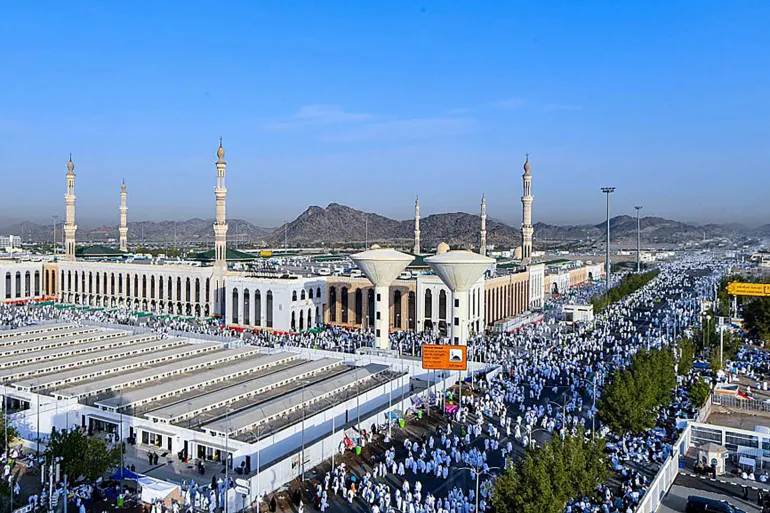Throughout the year, millions of Muslims from around the world travel to Saudi Arabia to perform Umrah and Hajj.
This spiritual journey begins at the Holy Mosque in Mecca which is the most important between KSA Islamic historical sites.
After that, the journey continues to the Prophet’s Mosque in Medina.
Yet, no pilgrimage is truly complete without visiting the many significant Islamic historical sites that reflect the life and legacy of the Prophet Muhammad ﷺ and his companions.
Key Islamic Historical Sites in Mecca
Hira Cave – The Birthplace of Revelation

Located atop Jabal al-Noor (Mountain of Light) northeast of Mecca, Hira Cave stands at an elevation of around 634 meters.
This is the very spot where the Prophet Muhammad ﷺ used to retreat for worship and where the first revelation of the Qur’an was received through Angel Jibreel (Gabriel).
The cave remains intact and can accommodate up to five people, offering a panoramic view of Mecca and its surrounding mountains.
Thawr Cave – The Shelter of Migration

Thawr Cave is situated within Jabal Thawr, on the Yemeni route south of Mecca, at an elevation of approximately 759 meters.
It is historically known as the cave where the Prophet Muhammad ﷺ and Abu Bakr Al-Siddiq (may Allah be pleased with him) sought refuge during their migration to Medina.
The cave lies about 3 kilometers from the Grand Mosque and remains a must-visit destination for pilgrims.
Mina – Valley of Rituals
Mina is a valley surrounded by mountains, located about 6 kilometers east of the Grand Mosque.
It is the site where major Hajj rituals such as the stoning of the devil (Ramy al-Jamarat) take place.
Pilgrims also spend the night here during the Day of Tarwiyah, Eid al-Adha, and the Tashreeq days, and it is where the ritual sacrifice (hadi) is performed.
Muzdalifah – The Night Between Rituals
Located between Mina and Arafat, Muzdalifah is where pilgrims rest after leaving Arafat.
Here, they perform Maghrib and Isha prayers together and collect pebbles for the stoning ritual in Mina. Staying overnight in Muzdalifah is considered a mandatory part of Hajj, and skipping it requires compensation.
Namira Mosque – Arafat Landmark

Namira Mosque is situated in Arafat, and it is the site where the Hajj sermon is delivered.
On the 9th of Dhul Hijjah, hundreds of thousands of pilgrims gather to pray Dhuhr and Asr in congregation, combining and shortening the prayers in line with the Prophet’s tradition.
Islamic Historical Sites in Medina
Battle of Badr – A Turning Point in Islamic History
In the village of Badr, located about 150 kilometers southwest of Medina, the first major battle of Islam took place.
Known as the Battle of Badr, it marked a decisive victory for the Muslims. Visitors often stop at the Graveyard of the Martyrs of Badr, where 14 companions of the Prophet ﷺ are buried.
Quba Mosque – The First Mosque in Islam

Located roughly 5 kilometers from the Prophet’s Mosque, Quba Mosque is the first mosque ever built in Islam.
The Prophet Muhammad ﷺ participated in its construction upon arriving in Medina.
Today, the mosque spans over 13,500 square meters and features modern facilities and expansions.
Mosque of the Two Qiblas – A Moment of Revelation
Masjid al-Qiblatain (Mosque of the Two Qiblas) lies about 8 kilometers from the Prophet’s Mosque.
It is historically important because it’s where the Qibla (direction of prayer) was changed from Jerusalem to the Kaaba in Mecca.
The moment occurred mid-prayer after a divine command was revealed, and the congregation immediately turned to face the new Qibla.
Al-Baqi Cemetery – Resting Place of the Companions
Jannat al-Baqi is the most famous cemetery in Medina and lies southeast of the Prophet’s Mosque.
It is home to the graves of nearly 10,000 companions, including most of the Prophet’s wives (except Khadijah and Maymunah).
Spanning around 180,000 square meters, Al-Baqi is a powerful reminder of the deep-rooted Islamic history of Medina.
Mount Uhud – Witness to Sacrifice

Standing tall north of Medina, Mount Uhud was the site of the Battle of Uhud, where many companions were martyred.
The nearby Martyrs’ Cemetery of Uhud and Mount Rumat (Archers’ Hill) are often visited.
The mountain consists mainly of red granite and lies near other smaller hills, such as Jabal Thawr (Medina) and Jabal Ainain.
Pilgrims visiting Mecca and Medina embark not only on a spiritual journey but also a historical one. Beyond fulfilling religious obligations, they experience a deeper connection to the roots of Islam by walking through Islamic historical sites that witnessed the earliest moments of the faith.
These sacred Islamic historical sites bring history to life, making every step a reminder of the Prophet’s ﷺ message and legacy.


